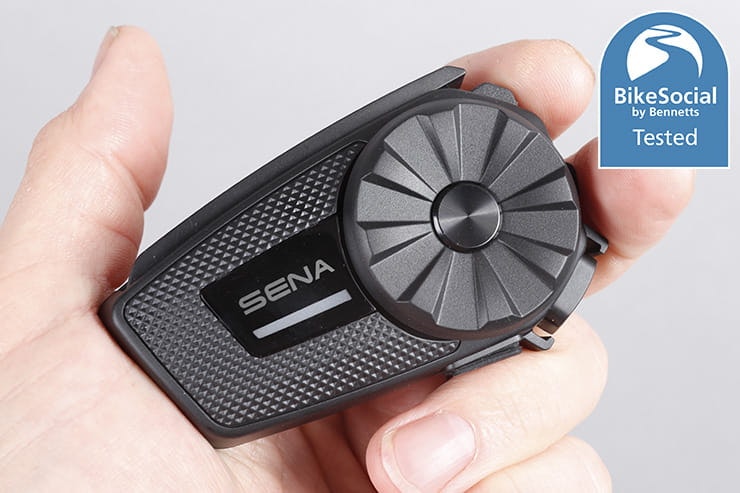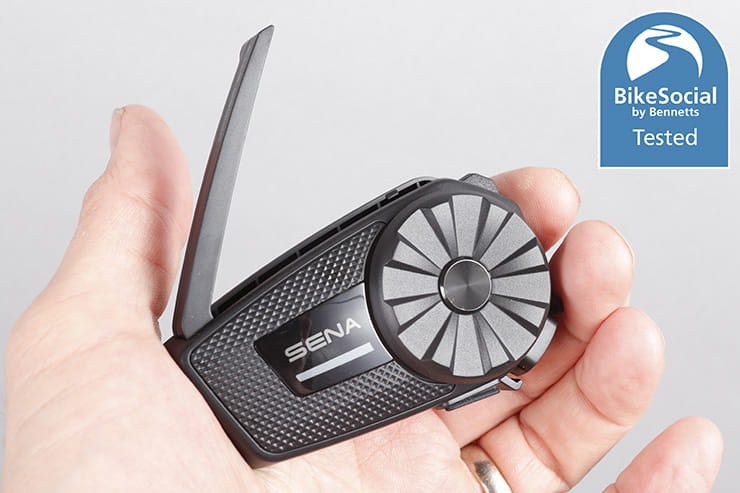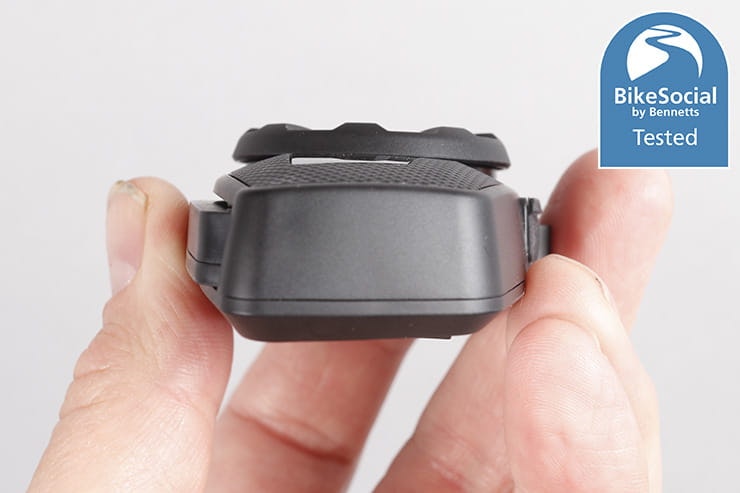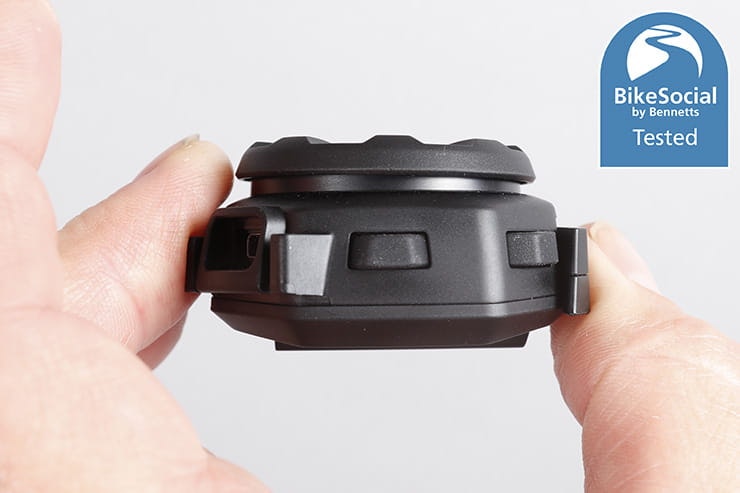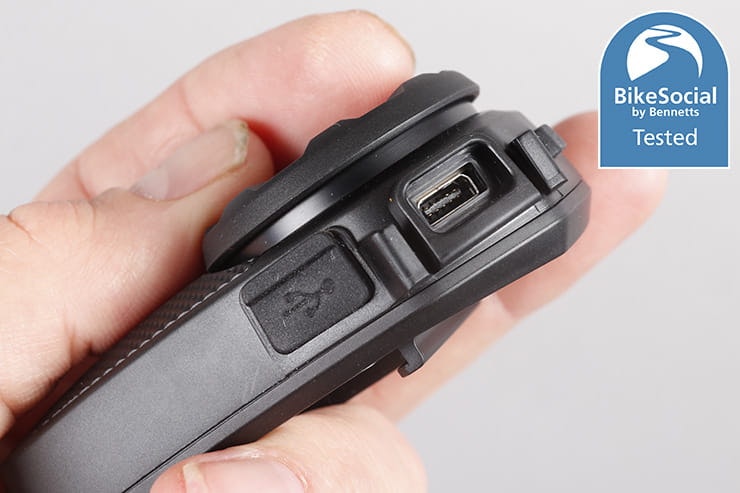Sena Spider ST1 review | Mesh headset & intercom tested
By John Milbank
Consumer Editor of Bennetts BikeSocial
15.03.2023
Date reviewed: March 2023 | Tested by: John Milbank | RRP: £209 | www.sena.com
With a typical street price currently of £149.99, the Sena Spider ST1 on review here represents a relatively affordable entry-level intercom that has some very impressive performance.
As you’ll see, it’s not perfect, but much of it (once set up) is so good that it could become a benchmark, especially for larger groups of riders heading out on a ride together…
Outstanding battery life
Excellent Mesh comms
Good compatibility
No radio
Questionable waterproofing
No wireless updating
Fitting
The Sena Spider ST1 comes with a comprehensive fitting kit, including an adhesive mount and a clip-on one that – unlike previous Sena mounts – doesn’t require any tools. I tried the ST1 stuck to the side of an AGV Tourmodular, and clipped onto an HJC C10.
Both a boom mic for flip-front lids, and a small Velcro-backed mic for full-face helmets are supplied, along with 40mm ‘HD’ speakers.
The only thing to be aware of with the Spider ST1 is that it’s not designed to be quickly removed from the lid for charging as the cable that attaches the speakers and mic to the unit locks into place. This isn’t a major problem of course, and with more comms systems being built into lids now, it’s not unusual. You’ll just have to have your lid by your charger.
There is a Spider RT1 available too, which has buttons instead of the jog wheel. On previous Senas I’ve reviewed, the ‘S’ and ‘R’ models were broadly similar besides this control variation, but the ‘S’ units used a quick-release mounting bracket that allowed you to pop the device off for easy charging. The disadvantage was that the S intercoms could suffer in very wet conditions as water could creep between the mount and the device.
The Sena Spider ST1 doesn’t have any IPX waterproof rating, but while it seems better protected from the rain than some others, I’m sorry to report that, under very extreme circumstances water can creep inside; it appears that the jog dial is the route in.
I use all intercoms I review in all weathers, but I also test them with a garden hose to simulate riding at higher speeds in torrential rain. While the Spider ST1 didn’t cut out like some previous Senas have in this test (they always return to normal when dry), I did find that about half an hour after testing it put itself into pairing mode; after opening the unit up I found water had got into it.
To be clear, this is an extreme test, and it’d take some pretty serious rain to affect the Sena Spider ST1, but if you’re worried about it, I’d suggest the Spider RT1, though this seems to have a higher street price at the time of writing.
Like other intercoms, the Spider can use a smartphone app to control it and to set it up, but on first connecting I was disappointed to be blocked by an ‘update required’ message. And even more frustratingly, the ST1 can only be updated by downloading the ‘Device Manager’ application to a computer (Mac or PC), plugging the Sena in via USB then running the update. To add to the annoyance, the direct Device Manager download on the Sena site is not the latest version, so that has to be updated as soon as you try to use it.
Frustrating, yes, and annoying when Cardo offers wireless updating on even its budget-friendly Spirit HD, but once set up everything does run smoothly.
A very basic quick-start guide is included, though you’ll really need to download the full instructions. Fortunately the manual’s available on the app, even without the intercom connected.
In my harsh testing, some water did get inside. Great to find an easily-replaceable battery though
Connections
Once set up, almost as soon as you power on the Sena Spider ST1 it connects to your phone. This is one of the advantages of Bluetooth 5.2, along with increased clarity. It’s important to understand though that this is a Mesh only device, which means that for communicating with any other rider – or even your pillion – unless you link through an app like Ruroc Chain or Discord they must have a Mesh intercom. And remember, there is no ‘universal’ Mesh system, although new Senas and Interphones are designed to play nicely. Sadly that’s not the case with the two market-leaders (Cardo has formed its own gang with Midland and UClear), so don’t get a Sena if you want to talk to mates who have Cardos.
And vice versa of course.
The fact is though that if there are more than two of you wanting to hold a conversation, Mesh is by far the best option as it doesn’t require the riders to stay in the same order on the road like with Bluetooth, and the number of riders who can join in is – with Sena at least – potentially limitless (Cardo’s maximum is still a very healthy 15).
The advantage Sena has is that its Mesh system is, by default, fully open, so all you have to do is turn on the intercom, tap the Mesh button and you’ll be connected to everyone else. Extremely simple.
Arguably of course, this could result in you ending up in conversations with other passing riders who you don’t know, and it’s probably why Cardo opted for a more private solution. However, the reality of riding in the UK is that you’ll be unlikely to come across many others – at least away from big events – using the same kit. And if you are concerned, just switch to one of the other 8 channels, or to ‘Group Mesh’, where up to 24 riders can talk on their own private channel.
The Sena Spider ST1 can connect to two mobile phones and a sat-nav, as well as an optional remote control if you want.
In my testing, the connections were flawless. With the Mesh intercom running with the Sena 50S, I was able to stream music from my phone, the volume just reducing as the other person spoke. Note that the Spider does not support music sharing to other riders or your pillion.
I then introduced a TomTom Rider sat-nav to the mix, which also communicated its instructions without any problems.
I ran the same tests using a Garmin Zumo XT, and while it did seem a little more of a faff to get the two paired (the Zumo and Sena were fully updated), once sorted there were again no connection issues whatsoever.
Control
There’s no voice control on the Sena Spider ST1, though that tends to be reserved for the top-end models with most brands.
The Spider’s controls are easy to use though, and the jog wheel makes quick work of adjusting the volume. A minor gripe for me is that to start and stop streaming music, you have to hold the jog wheel’s button down for one second. That’s not a long time, but when you want to stop it quickly to hear someone speaking, it’s a little frustrating. I’d have preferred a quick tap to play and pause.
Skipping forward and backward tracks is done by pressing the jog wheel in while rotating it forward or back – this can take a little bit of getting used to, but it’s fine.
While it’ll depend where you mount the Sena on your helmet, it can be possible to tap the control wheel at times, for instance when tilting your head to the left or reaching up to adjust the top vents on your lid.
Three phone numbers can be stored in the Sena Spider ST1 (programme them using the app or Device Manager), then to access them just tap the back button twice then rotate the jog dial to select the one you want before tapping the rear button again. You can also access the last number redial function this way.
While there’s no voice control built in, you can tap the back button once to access your phone’s voice assistant. I have a Samsung Galaxy S21, and have set up a routine to keep the phone unlocked when the Sena’s connected; I need to remember to unlock the phone first, but once done I can use the Google assistant. Note that routines aren’t available on all phones – my wife’s lower-end Samsung doesn’t have them.
Volume and clarity
I always wear earplugs (the EarPeace Ms are my current favourite), and while I do run the Sena at full volume, it’s plenty to be able to clearly listen to music. The supplied 40mm ‘HD’ speakers are able to drive at full power with no noticeable distortion.
Also extremely impressive is the clarity of phone calls: riding at 70mph in the budget HJC C10, my wife said there was no noise at all – she was sure I’d pulled over.
The Sena Spider doesn’t feature auto-volume for when you slow down, though the jog wheel makes changing it easy if you want to.
On Apple devices, the Sena’s volume control affects the volume of the device, but on Android – or at least my Samsung S21, the jog dial only affects the Sena’s volume. This isn’t the case with the latest Cardos, but it means that if you have your phone’s volume set low, you won’t be able to get full power. It’s easily cured by setting up a routine on the phone to set the volume to maximum when the Sena connects automatically. Or remembering to turn your phone’s volume to maximum.
I test all intercoms on the same straight, flat stretch of road. My wife stands at one end with an intercom of the same model (or at least the same brand and a higher spec), then I ride off while she continues to speak. I then note when the signal cuts out, and when it reconnects.
Sena Spider ST1 range
The range of the Sena Spider ST1 – when paired to a Sena 50S via Mesh – was outstanding; the furthest I’ve ever seen on any intercom.
Sena claims up to 2km, but I ran out of straight, line-of-site road before reaching that. After 1,300m I had to turn a corner, then after about another 150m or so the link broke. That’s getting close to a mile.
Riding about 500m to the next roundabout then coming back, reconnection was automatic and flawless as I got to the corner at 1,300m, allowing me to hold a very clear conversation with my wife as I rode back to her.
Very impressive results, but I must point out that the weather conditions were heavy, low cloud, which can help intercoms perform at their best. After several years of testing motorcycle comms I’ve learned a few very important points:
Intercoms never reach their claimed maximum range in real-world conditions
Weather make a big difference
Traffic, buildings and geography all play a part
Turning your head can lose a signal at distance
Carbon fibre helmets can have a seriously detrimental effect
This is a test of group mesh performance, which is carried out on a more typical rural road
Mesh devices allow for better group intercom performance as each rider acts as a relay station, and unlike Bluetooth, it doesn’t matter what order they ride in. That means that, in the test example above – which had plenty of buildings and trees – Rider 1 would normally be out of range of Rider 3, but Rider 2 acts as a relay between the two. When they swap order, everything still works as normal and they can all chat to eachother. Add more to the group, and as long as each rider can hold a signal with at least one other, they’ll all maintain comms.
Sena claims a range between the first and last rider of up to 8km (5 miles) as long as there are at least six riders in that group, but what you achieve will vary massively depending on the terrain, other traffic, buildings and weather conditions. However, the good performance and automatic reconnection makes this a great system for those who demand the best rider-to-rider comms.
Radio
Unfortunately the Sena Spider ST1 doesn’t have a built-in FM radio. While they’re never great on intercoms, I do like being able to easily switch to the radio if I fancy it.
You can of course use an app, like BBC Sounds for instance, to stream via your phone.
The Sena Spider ST1 is charged via a USB-C port
Sena Spider ST1 battery life
Another outstanding result: the Sena Spider lasted just under 27 hours while streaming music at full volume. That’s the longest of any intercom I’ve ever tested.
That was with the Mesh intercom turned off, which will of course draw power, and Sena claims a respectable – and entirely believable – 11 hours from the 850mAh cell inside.
20 minutes of charge is said to give up to two hours of Mesh chatter, while a full charge should take about an hour and a half.
The battery level might be shown on your connected smartphone’s home screen, or you can check on the app. When power is very low, the Spider will say ‘low battery’, but otherwise the only indication of charge remaining is the LED startup sequence: four red flashes for full, three for medium, two for low. I do much prefer Cardo’s system of speaking the remaining battery percentage as the device is powered down.
I’ve never had issues with any Sena or Cardo intercom’s batteries over more than five years of testing, but it's worth celebrating the fact that getting to the battery requires the removal of just five standard Philips-head screws, pulling the back of the case off, then unplugging the 3.7V cell. iFixit would be proud, assuming you can get spares!
Ease of updating
The lack of any wireless updating is disappointing. The Sena 50S can do it, but it requires a special charging cable with WiFi built in (I tried it, and couldn’t get it to work with the ST1), but Cardo achieves it even on its most budget offerings.
Three alternatives to the Sena Spider ST1
If you never intend to use rider-to-rider comms, or you just want to talk to your pillion, there are some better choices out there for less money. If you do want to talk to others though – especially in larger groups – keep in mind the compatibility issues. With Sena being the OE brand of Shoei and Schuberth, there’s a good chance that others in your circle will already have them…
If streaming music, a radio, pillion comms and directions from a sat-nav are all you need, the Cardo Spirit HD is an outstanding piece of kit. It retails at £139, but has a street price of around £112.
If you want to chat to your mates, and want all the bells and whistles, go for the Sena 50R if they have the same brand. It retails at £333, but can be found for about £235 at the time of writing. Full review of the Sena 50R here.
If you want a top-spec Mesh Cardo, the Packtalk Edge is one of the best intercoms I’ve tried. It retails at £356, but is available at £289.99 at the time of writing. Check out the full review of the Cardo Packtalk Edge here.
These are just three of many alternatives – you can find all the motorcycle intercoms we’ve tested here and be sure to regularly check for the discounts available through Bikesocial membership.
Buying tip: Save on your Sena without a discount code or voucher
As you probably know, VAT isn’t chargeable on motorcycle helmets in the UK, but that also means that, in many cases, if you buy the OE intercom at the same time, you don’t pay the VAT on that either.
At the time of writing, Sportsbikeshop is also offering 16.66% off most intercoms when purchased with a helmet, which takes the price of the Sena Spider down to £125 at the time of writing. And you don’t need to use any discount codes or vouchers!
Sena Spider ST1 review: Verdict
If all you want an intercom for is to listen to music then the Sena Spider ST1 is, arguably, over-specified. The lack of radio is also a disadvantage compared to others, and even if you just want to talk to a pillion, they’ll have to have a compatible Mesh intercom.
But for a group of mates looking to stay in touch on a ride, Mesh intercoms really are the very best option, and I have to say that Sena’s implementation is superb thanks to the default open connections; simply power up, turn on the Mesh intercom and you’re connected. If you and a few buddies want to keep in touch, this is currently one of the best ways to do it.
